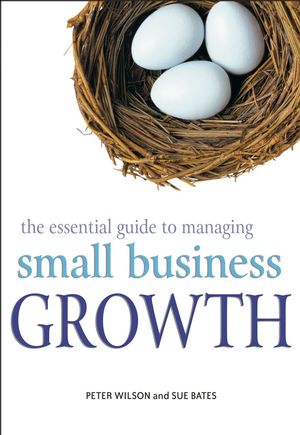The Essential Guide to Managing Small Business GrowthISBN: 978-0-470-85051-0
Paperback
256 pages
August 2003
 This is a Print-on-Demand title. It will be printed specifically to fill your order. Please allow an additional 10-15 days delivery time. The book is not returnable.
|
||||||
Preface.
1. Managing Business Growth.
Making the transition.
The relevance of management theory to growing business.
Managing effectively and efficiently.
Setting realistic goals.
Synopsis of the book.
2. Making Sense of Strategy.
Strategic issues: Setting the scene.
The Titanic: A salutary lesson in strategy.
Review of current performance.
Analysing competitive forces.
Market segmentation: Defining customer behaviour.
Strategic marketing analysis.
Distinctive competence.
Hygiene factors.
Defining core competences.
Completing the strategic review: SWOT analysis.
Setting strategy.
Phase 1: setting out the options.
Phase 2: evaluating the options.
The chosen strategy.
Stretching your organization.
Organic growth vs merger or acquisition .
3. Marketing for Profit.
Customer behaviour.
Market segmentation.
Profiling the custoner.
Competitor analysis and distinctive competence.
Market positioning.
The marketing mix.
Products and product differentiation.
Pricing.
Place: channels of distribution.
Promotion: communicating the offer.
People: organizing the marketing function.
People: key skills, knowledge and qualities.
Relationship marketing.
Customer relationship management (CRM).
Customer feedback.
Market research.
The marketing plan.
Postscript: action on ABCO’s marketing problems .
4. Developing an Organization that Delivers the Strategy.
Understanding organization.
Organizational maintenance and development.
The origins of an organization.
How organizations work: structure, people, processes and systems.
Structure.
The form of the organization.
People.
Processes and systems.
Specifying jobs and people to fill them.
Other influences on organization.
Organizational diagnosis: how to overhaul your organization .
5. Getting Performance from People.
Attention to task and to people processes.
People and productivity.
Personal resources and self-management.
Managing priorities and getting things done.
Understanding motivation.
Positive motivation, dissatisfaction and demotivation.
Getting Performance from people.
Briefing and contract setting.
Monitoring.
Feedback and review.
Dealing with entrenched performance problems.
Feedback, learning and growth .
6. Leading the Team.
Power in the growing organization: making it safe to delegate.
Leadership and delegation.
Leadership style.
Working with teams.
Balancing attention to task with attention to people and processes.
Team roles: composition of the successful team.
Stages of team development.
Matching team processes to task situation.
Finding people for the team.
Aligning people with purpose: using performance appraisal effectively.
A workable appraisal system.
Conducting an appraisal meeting.
Systematic development of competencies.
Recruiting new people.
Selection interviewing.
Avoiding recruitment pitfalls.
Induction of new recruits.
Building and leading the team: the underlying skills .
7. Culture, Creativity and Change.
Culture and the growing organization.
What is organizational culture.
Understanding the organization’s culture.
Is there a small-business culture.
The influence of founders and owners.
Structure, empowerment and the can-do culture.
Influencing culture positively.
Maintaining freshness: encouraging better ways of doing things.
Renewal through learning, contribution and growth.
8. Managing Business Performance through Financial Analysis.
The financial statements.
Accounting principles.
Exploring the profit and loss account.
Exploring the balance sheet.
Presentation of accounts for sole traders and partnerships.
Maintaining adequate capital.
Cash-flow statement.
Why is profit not the same as cash?
Financial analysis.
Using ratio analysis to understand financial performance.
9. Management Information Systems and Financial Controls.
Controlling profit and cash.
Controlling profit: the P&L account.
Managing strategy through gross profit margin.
Costing and pricing reviews.
Controlling cash: the balance sheet.
Controls on working capital.
10. Planning for the Future.
Types of business plans.
The strategic business plan.
Stages of strategic planning.
Preparation.
Business review.
Customer feedback and market research.
Setting objectives.
Setting corporate strategy.
Financial adequacy.
Reviewing and revising the strategic plan.
Operational action plans.
Monitoring the strategic plan.
11. Hazards on the Path to Growth.
Stay focused or venture into new markets?
Failure to let go.
A future role for the founder.
Appointing a successor to the founder CEO.
Family members on the payroll.
Failure to delegate effectively: undermining management.
Owner-manager guilt as a barrier to growth.
Note.
Appendix 1: Example of a Strategic Business Plan.
Appendix 2: Example of a Marketing Plan.
Appendix 3: Example of a Job Specification.
Appendix 4: Costing and Pricing Example.
Index.



